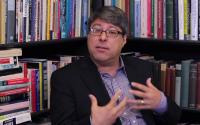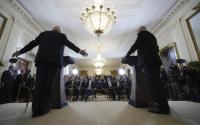Common Dreams / Published on Wednesday, August 17, 2005 by Inter Press Service
Civil libertarians and the Pentagon appear headed for yet another trainwreck in the ongoing dispute over the so-called second batch of photos from Abu Ghraib prison in Iraq.In response to a lawsuit by the American Civil Liberties Union (ACLU), the Centre for Constitutional Rights (CCR), and a number of medical and veterans groups demanding release of 87 new videos and photographs depicting detainee abuse at the now infamous prison, the chairman of the Joint Chiefs of Staff, Gen. Richard Myers, said the release would result in ”riots, violence and attacks by insurgents.” In court papers filed to contest the lawsuit, Gen. Myers said he consulted with Gen. John P. Abizaid, head of the United States Central Command, and Gen. George W. Casey Jr., the commander of the U.S. forces in Iraq. Both officers also opposed the release, Gen. Myers said. He believes the release of the photos would ”incite public opinion in the Muslim world and put the lives of American soldiers and officials at risk,” according to documents unsealed in federal court in New York. ”The situation on the ground in Iraq is dynamic and dangerous,” Myers added, with 70 insurgent attacks daily. He also said there was evidence that the Taliban was gaining ground because of popular discontent in Afghanistan. Gen. Myers cited the violence that erupted in some Muslim countries in May after Newsweek published an item, which it later retracted, saying that a Koran had been thrown in a toilet in the United States detention center in Guantánamo Bay, Cuba. He also said the images could fuel terrorist disinformation campaigns. ”It is probable that Al Qaeda and other groups will seize upon these images and videos as grist for their propaganda mill, which will result in, besides violent attacks, increased terrorist recruitment, continued financial support and exacerbation of tensions between Iraqi and Afghani populaces and U.S. and coalition forces,” he said. The 87 ”new” photos and four videotapes taken at Abu Ghraib were among those turned over to Army investigators last year by Specialist Joseph M. Darby, a reservist who was posted at the prison. In legal papers unsealed last week, the ACLU and its allied groups urged the court to order the release of photographs and videos, and also asked the court to reject the government's attempt to file some of its legal arguments in secret. It said that until the first photos of detainee abuse at Abu Ghraib were made public in April 2004, the government had consistently denied that any wrongdoing had taken place, despite news reports to the contrary. Since then, the ACLU has obtained, through a court order, more than 60,000 pages of government documents regarding torture and abuse of detainees. At a court hearing on Monday, the judge said he generally ruled in favour of public disclosure and ordered the government to reveal some redacted parts of its argument for blocking the release of pictures and videotapes. U.S. District Judge Alvin K. Hellerstein said his rulings pertained to arguments by Gen. Myers. ”By and large, I ruled in favour of public disclosure,” he said. The judge said he believes photographs ”are the best evidence the public can have of what occurred” at the prison. He scheduled arguments on the question of whether the photographs and videos should be released for Aug. 30, saying a speedy decision is important so the public's right to know isn't compromised. The ACLU has also called for an independent counsel with subpoena power to investigate the torture scandal, including the role of senior policymakers, and has filed a separate lawsuit to hold Defence Secretary Donald Rumsfeld and high-ranking military officers accountable. Reed Brody, head of international programmes for Human Rights Watch (HRW), told IPS, ”The problem is not the photos but the policy of abuse. The release of the first photos last year led us to the revelations that senior U.S. officials had secretly sidelined the Geneva Conventions, re-defined 'torture', and approved illegal coercive interrogation methods.” ”The release of new photos showing crimes perpetrated on detainees could create new impetus to expose and prosecute those ultimately responsible and hopefully prevent these practices from being repeated.” Michael Ratner, president of the Centre for Constitutional Rights, noted that, ”The administration's response to the release of the photos is to kill the messenger, rather then to investigate and prosecute the real culprits: Secretary of Defence Rumsfeld, Attorney-General Alberto Gonzales, Generals Miller and Sanchez, and others.” He agreed that ”the photos will be upsetting to anyone who cares about humane treatment and particularly to those in the Muslim world, but the photos reflect the reality of the type of treatment detainees were subjected to.” ”Rather than suppress the best evidence of widespread torture of Muslim detainees, the Administration ought to launch a fully independent investigation and ought to see that an independent prosecutor is appointed,” Ratner told IPS. He added, ”Ensuring accountability for the torture conspiracy is the best way of demonstrating to the Muslim world that this outrage has come to an end and will not be repeated.” The government initially objected to the release of the images on the grounds that it would violate the Geneva Conventions rights of the detainees depicted in the images. That concern was addressed by court order on Jun. 1 directing the government to redact any personally identifying characteristics from the images. The ACLU did not object to those redactions. The ACLU said the government has repeatedly taken the position that the detainees themselves cannot rely on the Geneva Conventions in legal proceedings to challenge their mistreatment by U.S. personnel. In a court declaration, former U.S. Army Colonel Michael E. Pheneger, a retired military intelligence expert, responded to the government's ”cause-and-effect” argument that release of the images would spark violence abroad. ”Our enemies seek to prevent the United States from achieving its objectives in the Middle East,” he said. ”They do not need specific provocations to justify their actions.” Attacks by insurgents ”will continue regardless of whether the photos and tapes are released,” he added. The case arose from a lawsuit filed under the Freedom of Information Act (FOIA) by the ACLU, the Centre for Constitutional Rights, Physicians for Human Rights, Veterans for Common Sense and Veterans for Peace.






